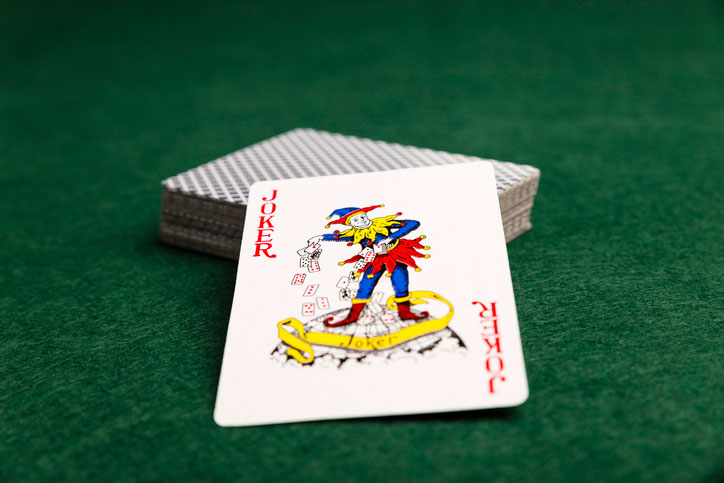9 Reasons Not to Listen to Them…the Jokers!
8/27/2019

Part 3 of 5 … Join us in the third installment of a five-part series that tells the story of how one dedicated principal observed positive change in the classroom when teachers incorporated the principles and philosophy from the popular book, The Wild Card by Hope and Wade King.
I have always been a high energy kind of dude, but how many times have I had people make comments about the projects I did in my classroom, or the ones I'm doing now in my school as a principal? These comments sometimes are said directly to me and are backhanded, while others get retold to me from mutual friends. In addition, I sometimes have negative self-talk about what I can and cannot accomplish. This holds me back sometimes from reaching my potential.
If I truly took to heart what these people were saying as well as my own self-doubts, I would have left education my first year. In Wild Card, a book by Hope and Wade King, they label and describe this self-doubt and negative internal talk as "jokers." I have expanded that to also include the people who make comments that may hold you back.
In my first year of teaching in Lakeside, Montana I created a school-wide reading program. I had just moved back from Alaska and I was highly engaged with the Iditarod Sled Dog Race. I had brought back a half scale model of a dog sled that was given to me as a gift. I was excited to hang it in our school's entryway. I then created an 8' by 8'map of Alaska. A picture of a dog sled was then used to track each classroom's reading. The sleds would travel from Wasilla to Nome … a distance of over 1,000 miles. Each scale mile the sleds moved across the map was equated to the number of minutes students read in the classroom. Students and (most) teachers loved watching the dog sleds move across the map as students updated it once or twice a week to show progress.
Then…a "joker" comment was made, "You are not going to continue to do this (big project) when you are my age and have kids."
I didn't quite know how to respond to this comment. I could agree and say, "Yes, I have time now and I love doing this stuff." I could also disagree, which is what I wanted to do, and say, "No, I hope I don't lose the love and passion for learning with kids."
Small digs like that have occurred all throughout my 20 year career in education. Sometimes they come from parents, but they hurt the most when they come from colleagues. The comments can play into your psyche, and determine your self-worth at times. They can even hold you back from greatness and creative breakthroughs.
The worst comment I received one year was, "Keep it up, you make us all look good." When you dig into this comment, you find that the person actually wants you to do the opposite. They are worried about what you are doing because they possibly look bad for not doing it too.
If you need more convincing as to why you shouldn't listen to these jokers - and your own self-doubt - then here are nine reasons why you should ditch it all!

1 - Taking A Risk is Scary, but Necessary!
Stepping outside of the normal teaching routine can be downright scary. Not only does the fear of failure set in, but the fear of what students will say when the lesson flops creates even more stress. The routine we fall into day after day can provide the necessary structure for ourselves and may even be beneficial for some students who strive for the same structure. Unfortunately, mundane and rote routines only promote engagement and retention with a certain number of students. Many students need stimulation that creates excitement and enjoyment of learning to achieve their potential. Simple observation of engagement strategies reveal how they relate to student achievement… the higher the level of engagement, the higher the chances of retention.
In the book, Wild Card, Hope and Wade King encourage teachers to step outside their comfort zone and try some new instructional and engagement strategies. This is something that benefits both the teacher and the student. For example, a room transformation may put students (or doctors, in this exercise) into an operating room wearing medical scrubs and masks while dissecting multi-syllabic words. This simple idea can create life-long memories for students who now make the connection between using a scalpel for the dissection and pronunciation of new vocabulary words.
Taking a small calculated risk first leads to a better success rate. When something flops, we must be honest and tell students we as teachers make mistakes and have failures just like them. We may be showing our vulnerability, but we are letting them know it is okay to fail. Failing and making mistakes is an opportunity for new learning to take place (see #3 below).

2 - Eliminate the Need to Compete or Compare, Have Fun!
When looking down the hallway, it may be hard not to compare what we are doing with another teacher. We see that one specific teacher is always implementing grandiose ideas and putting on what looks like a big show. We may think in our head, we can't do that. If we continue to compare and judge, we will find ourselves being complacent and unhappy with our instruction. It is interesting though that that one specific teacher and her students seem happier, and it looks like she even enjoys her job more than you.
Eliminating the need to compare can set you up for some fun, too. Do something different - don't be afraid to be yourself. What types of interests do you and your students have that would make a great learning experience? When you delve into that simple question, the world can be your oyster. As mentioned above, I took my love of the Iditarod and created a school-wide reading program that tracked minutes read. We set a school-wide goal. Though our school culture allowed for a little healthy competition, it was based on goal setting and competition with ourselves. Each student wanted to contribute to moving their dog sled on the map. I didn't set this reading program up to compete with other teachers in my school building. I developed the program so we can all share a combined positive culture-building experience, and the bonus was increasing our reading enjoyment and achievement. If you can keep culture-building as the premise for your instructional decisions, students will automatically have increased engagement with the bonus of increased achievement.
A second grade teacher in my school transformed her classroom room into Jurassic park. All made from cheap school supplies, a 6' foot volcano was created, desks put together that resembled Jeeps, and huge Easter eggs were painted to resemble dinosaur eggs. When teachers visited her classroom they were in awe until she explained some of the simple materials she used to create Jurassic Park. This inspired other teachers to do room transformations of their own. The best advice is to "do you" and "have fun." Find something that is unique to you and your students, or simply pull an idea from Pinterest, tweak or copy, and begin.

3 - Mistakes are Where the New Learning Goes!
Never failing or being a perfectionist can actually be detrimental to our students. Students must see how we handle adversity and failure. In fact, using the mantra, "Mistakes are where the new learning goes," gives students permission to fail or make a mistake. If we do not teach that failure is a part of success, then we are doing our students an injustice. Failure has been a part of every single invention in history. It doesn't take much research to find an invention that took years to perfect or develop. Yes, there are inventions where someone may stumble onto an idea accidentally, but I can almost guarantee it took some failures to perfect that invention.
Problem solving and perseverance are two qualities that should be taught in every classroom. I believe they are just as important as the content they are learning, if not more so! Anyone can take an I-phone into a college exam and pass it if they were allowed to use it as a tool for the test. Problem solving is the key. In fact, we want students who can problem solve a situation no matter how excruciating it may be. We want them to persevere through this problem solving cycle, and we know it is the most important quality they can develop for their continued success. Angela Duckwork's work on grit dramatically portrays this idea. As you may know, grit can be synonymous with perseverance, and both words are intrinsic values that are difficult to grow. We as educators must figure out how these characteristics can be part of everyday instruction.
Cultivating grit in our classrooms means we accept failure and teach our students how to overcome this feeling of adversity. It might be the single most determining factor in that student's life.

4 - Ignore the Naysayers!
Jealousy and ignorance may run rampant in your school. In fact you may even hear other teachers cutting up their fellow colleagues on a routine basis. So, why should we step outside of the box if we know these naysayers are going to be making negative comments? Whether these comments are directly to our face or behind our back, we owe it to our students to create a learning atmosphere that breaks down these barriers. A great mantra to use with colleagues and your classroom can be stated with these powerful words, "Create the world you want to live in."
A teacher who can ignore naysayers can set themselves and their students up for success. No matter the comments, looks, or actions, you are modeling for your students that positivity, creativity, and how a growth mindset can set you free. Being set free means we are free to learn, free to have fun, and free to enjoy our time together. We are creating problem-solving citizens in our classrooms that will be contributing to society much the same way they have seen it modeled.

5 - No Matter Your Years of Service, Start Now!
It may seem like the teachers with all the energy and grandiose projects are young whipper-snappers just starting out. This is a myth. In fact, many tenured and seasoned teachers transform their classrooms, inject new types of energy, and take on engaging projects for their children. These teachers understand that their students should get the best…someone excited about learning…they deserve it. In the book, Kids Deserve It by Todd Nelsoney and Adam Welcome, the authors state,
"Kids deserve an excited adult. They need someone who's ready to explore and laugh with them all day - someone who's looking for those magic moments, full of high fives coming down the line with energy radiating all around."
Notice how this quote does not specify an age range. You can bring the energy and ideas from the book, The Wild Card, into your classroom as soon as you make the commitment. You are never too old to infuse new ideas and energy into your instruction. The sooner you start, the more fun and excitement you and your students will enjoy.

6 - Extravagance is Stressful, Start Small!
When becoming a Wild Card Teacher, start small. You can try a room transformation. It is more than adding decorations or changing around your room. It is a philosophy that comes with creating a multi-sensory experience for learning that ties in all curriculum areas for a unit. If you get on Pinterest or even Youtube to learn more about classroom transformations, you will find many that are extravagant and seem time consuming. Yes, there are a number of teachers that go over the top with creating elaborate and even expensive transformations.
What I recommend is looking for an easy win to start your path. Find a room transformation that fits your curriculum and standards, and that can be done in under an hour. Starting small will help you have success with your first transformation. Understand that students will still be amazed that you have tried something different in the classroom. Your excitement around getting it ready will spread to the students. One of our fourth grade teachers this year did a pirate themed room transformation with a large ship, captain's wheel, and even a plank for students to walk. She recorded their faces and reaction when they came into the room. Students were loud, almost screaming, with excitement as they could not wait to start the day of learning.

7 - Your Students Will Remember the Experiences First and Foremost!
No matter the size and effort of a room transformation, your students will remember the experience and feeling. They will even remember a substantial amount of the associated content. When asked what they learned ten years down the road, they will most likely be able to tell you both the feeling and the curricular area that was being taught. If you understand this poignant fact it makes us realize we need to try this for our students.
When I think back to my own learning experiences when I was young at Fort Benton Elementary (side note: I frequented the principal's office routinely), I do have strong memories of my experiential learning. One of my favorites was a simulation game in 5thgrade that dealt with the European Explorers to the New World. The teacher spent time getting the room decorated with some pirate theme, as well as sailing garb. Each day we would work in small groups to survive the boat trip from one of the European countries to the New World. Every student was engaged and sat on the edge of their seats as the teacher read the weather forecast and other related events that affected our voyage. I remember the feeling of this experience as well as some of the content…30 years later.
We have to continue creating learning experiences that engage multiple senses, as well as infusing excitement into learning if we want the information to stick. I understand that this cannot be done for all curriculum areas as it would be an excessive amount of time and effort. If we start small and create instructional learning that connects with students, we are on the correct pathway.

8 - Creativity is In the Eye of the Beholder
Creativity seems to be abundant with certain teachers. They know how to precisely take an idea and make it their own to connect with students. Jealousy may set in and you may think that this teacher is just so much more creative than you. I am here to tell you, most of the great ideas we see in classrooms are already being done by someone else. If we take time to research, we can find an idea that is similar to our original thought, then we can make it our own.
As educators we were taught to beg, borrow, and steal ideas as we started our careers. If you are like me with 20 years under my belt, I have been able to collect a plethora of ideas for classrooms. When I implemented them, I always put a little twist onto the original idea to make it my own. It becomes quicker the more you implement these new ideas. I always felt my creativeness was quite low as compared to all teachers in my school. I learned it doesn't take much to impress and engage your students. Some of the smallest things can be used as props to get students engaged. Creativity is truly in the eye of the beholder.

9 - Fixed Mindsets Prevent Creative Breakthroughs
Carol Dweck's work with Growth Mindsets has revolutionized the way we talk to our students, and even our own children at home. We are reframing language, giving examples, and even practicing words we can use when problem solving or tackling a new learning task. When someone has a fixed mindset they are having a difficult time giving up the preconceived notions, as well as possibly battling their own self-talk or "jokers."
A fixed mindset tells us we are not good enough, nor creative enough to pull off a room transformation and change our instruction. In fact, a fixed mindset will stymie all creative ideas you may have for your classroom. If we want students who are growth minded, then we must also practice being growth minded ourselves to ensure it is being modeled correctly.
A growth mindset supports breakthroughs, allows for risk taking, and gives us permission to fail and to try again. As I said earlier, "kids deserve it." We must not let our "jokers" override our passion and energy in providing powerful and engaging learning experiences.
Continue reading... find the fourth installment of Jon Konen's 5-part Wild Card Series here.
- Learning How to Say No and Set Boundaries with Parents - November 21, 2022
- If You Had Only One Behavior Strategy to Use in Your Classroom, What Would It Be? - September 26, 2022
- Live Your Code: 7 Strategies That Will Help You Be the Most Effective Educator You Can Be - August 15, 2022












